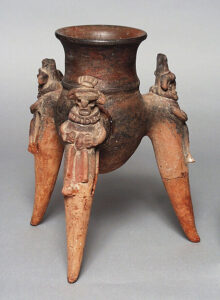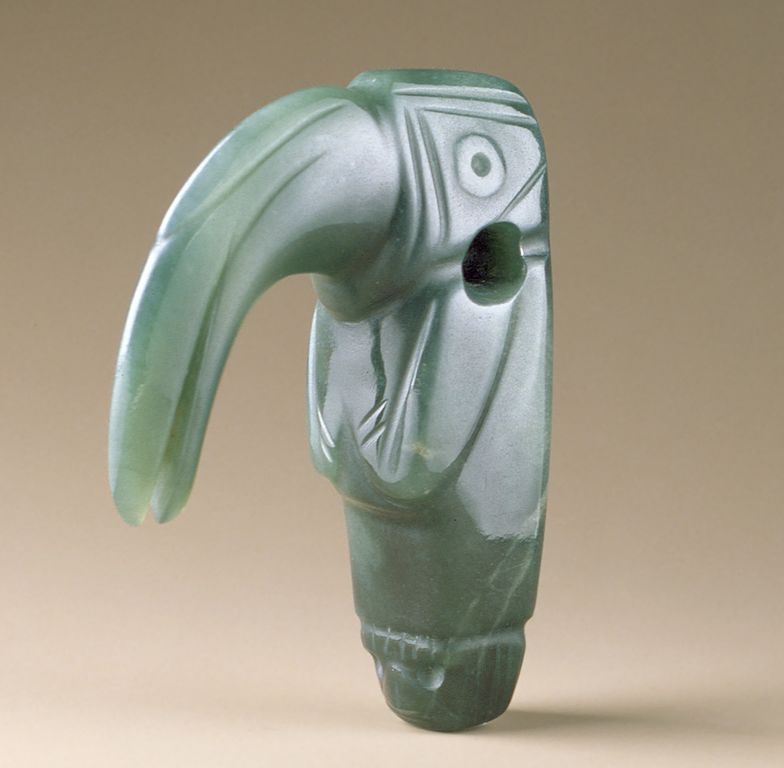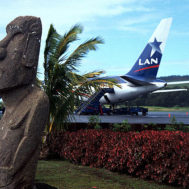Comments By Global Heritage Alliance and the Committee for Cultural Policy on MOU Request from the Government of Costa Rica
The Global Heritage Alliance (“GHA”) and the Committee for Cultural Policy (“CCP”)[1] are pleased to comment on a proposed Memorandum of Understanding (“MOU”) with Costa Rica.
If that MOU is recommended, any such a MOU should be conditioned on limiting the designated list and holding Costa Rica accountable to reasonable benchmarks that address congressionally mandated self-help measures. Moreover, any restrictions must be prospective, limiting detention, seizure and forfeiture to items illicitly exported from Costa Rica after the effective date of any governing regulations. Under no circumstances should restrictions be applied to items that are neither archaeological nor ethnological in character.
Background
- Historical Overview

Collared aracari (Pteroglossus torquatus) in Costa Rica. Author LG Nyqvist, 7 March 2017, Creative Commons Attribution-Share Alike 4.0 International license
Costa Rica’s sophisticated Pre-Columbian cultures are nowhere near as well-known as the native cultures in Guatemala and Mexico to the North and Peru in the South for two reasons. First, unlike the Aztecs in Mexico, the Maya in Mexico and Guatemala, and the Inca in Peru, the native cultures in what is today’s Costa Rica built with biodegradable materials, not stone. Second, Costa Rica’s original populations largely died out after Spanish settlers brought infectious diseases, primarily the measles and small pox, to the area. Today, fewer than 2% of Costa Rican peoples are considered indigenous, primarily living within reserves located in remote or mountainous areas.[2] The vast majority of today’s Costa Ricans therefore do not have the same connection to the country’s Pre-Columbian past as do inhabitants of countries with large indigenous populations.
Cost Rica’s roots are Spanish, but the country developed in a far different manner than much of the rest of Latin America. Christopher Columbus reached Costa Rica on his Fourth Voyage to the New World, in 1502. The Spanish gradually settled in the area, which nominally became part of the Vice Royalty of New Spain. In fact, however, because the area lacked gold and silver mines or a large indigenous population that could be impressed into forced labor in large haciendas, quite unlike most of the rest of the Spanish Empire, Costa Rica developed into a largely autonomous and individualistic agrarian society of small land holders. So, while the Spanish Governor in 1719 purportedly described Costa Rica as “the poorest and most miserable Spanish colony in all America,”[3] those very conditions ultimately allowed Costa Rica to avoid many of the problems facing other Latin American countries today.
Costa Ricans never saw a need to seek independence from Spain because Spanish authorities largely left them alone. Nevertheless, Costa Rica’s colonial bonds were in effect broken for it when Guatemalan authorities declared independence from the Spanish Empire for all of Central America. Ultimately, there was a civil war in Costa Rica between those who wished to attach their fortunes to the Mexican Empire to the North and those who wanted Costa Rica to remain independent. These latter Republican forces ultimately won the civil war with Costa Rica then becoming an independent state in 1838.

Flying Panel Metate, Atlantic Watershed, 1st–5th century, Stone, Metropolitan Museum of Art, NY Gift of Fine Art of Ancient Lands Inc., in memory of John R. Ogle, 1986, Creative Commons CC-Zero, Creative Commons CC0 1.0 Universal Public Domain Dedication.
Costa Rican’s economy for many years was largely agricultural with coffee being the predominant crop. However, in the late 1800’s after the building of a railroad significantly eased long distance transportation of agricultural products, the United Fruit Company from the United States created large banana plantations which in turn prompted the creation of a strong trade union movement.
In the early part of the 20th century, more political unrest again led to a civil war. After the war ended, the victorious rebels disbanded the Costa Rican military, a move that has probably helped Costa Ricans maintain its democracy against military coups that have plagued other Latin American countries.
In the past several decades, Costa Rica’s economy has changed from being primarily agricultural to one based on manufacturing and tourism.
- Collecting Costa Rican Artifacts
During the late 19th century, railroad and United Fruit Company magnate Minor C. Keith amassed a huge collection of Costa Rican archaeological objects which he subsequently bequeathed to the Brooklyn Museum. In 2011, the museum decided to retain 10% of these objects and return the rest, approximately 5,000 artifacts, to Costa Rica. (The Brooklyn Museum is Giving About 5,000 Pre-Columbian Artifacts to Costa Rica, ArtDaily (Feb. 11, 2011) (last visited March 9, 2020).
Under Costa Rican law, the state has declared ownership over any archaeological object found after 1938. Still, enforcement of this law has been lax. From the 1960’s until the early 2000’s, a colorful and controversial antiquities dealer, Leonardo Patterson, allegedly shipped thousands of archaeological objects from Costa Rica. For decades, Patterson was in the good graces of some of Costa Rica’s most powerful politicians, who even awarded him with diplomatic posts. Patterson—who grew up dirt poor—has an interesting life story. He first became interested in antiquities as an apprentice in a jewelry shop where he was tasked with buying gold artifacts from farmers which would then be thrown into the melting pot. Patterson—who saw himself as saving history—decided instead to go into business selling what would otherwise be destroyed. Operating primarily out of Germany, Patterson sold Pre-Columbian artifacts to the rich and famous, until he was targeted for facilitating the looting of Latin American sites, first in the United States, then in Spain and Germany. See Tom Mashberg, Antiquities Dealer Leonardo Patterson Faces New Criminal Charges, The New York Times (Dec. 8, 2015) (last visited, March 10, 2020).

Crocodile Effigy Incense Burner, earthenware, AD 500-1350, Walters Art Museum, Gift of John G. Bourne, 1990s, Walters Art Museum, Baltimore, MD, Creative Commons Attribution-Share Alike 3.0 Unported License.
In many ways, any focus on past, historic looting on behalf of railroad and banana millionaires or colorful and controversial dealers like Leonardo Patterson just obfuscates the real issues. Local corruption is presumably a continuing problem. For example, in 2011, the Director of the National Museum was sacked from her post when 100 artifacts were discovered in the home of her aunt and uncle. (Alex Leff, Costa Rica: One museum’s junk is another’s treasure, PRI Global Post (Feb. 11, 2011) (last visited March 9, 2020).
Moreover, to the extent it still takes place, rural poverty probably remains the driving factor in any looting. Anthropologist David Matsuda has written extensively about subsistence looting in Central America by poor farmers. He has harshly criticized stereotypes of looters in the popular press as ignorant peasants. David Matsuda, Subsistence Diggers in Who Owns the Past? 255, 263 (Kate Fitz Gibbon ed. Rutgers 2005). Instead, he notes that the diggers themselves regard the debate over who owns loot as an aspect of class warfare. He paraphrases the words of one such digger as follows,
Every year the archaeologists dig up the artifacts and take them away. The next year they come back with more money, people and equipment. They talk of our ancestors with reverence, but treat us like ignorant peasants. The excavations are often run like plantations where we are exploited. The archaeologists want strong backs and weak minds. When we work for them, they pay us little and do not treat us with respect. We are never asked what we think, and there is no chance for advancement. The artifacts represent money and power to archaeologists. That is how they make their upper class living. To us, these gifts from our ancestors mean seed corn, food, clothes and security. This is how we live our lower-class lives.
(Id. at 264.)
Nevertheless, it appears likely as Costa Rica has moved away from an agricultural based economy that involves disturbing the land, fewer artifacts are being looted from unknown archaeological sites as was the case in the past. Certainly, Global Heritage Alliance and the Committee for Cultural Policy’s research failed to locate any discussion of current, as opposed to historic looting.
U.S. Law
The Cultural Property Implementation Act (“CPIA”), 19 U.S.C. §§ 2601 et seq. contains significant procedural and substantive constraints on the executive authority to impose import restrictions on archaeological and ethnological objects. The Cultural Property Advisory Committee (“CPAC”) is to provide the executive with useful advice about this process. Id. § 2605. “Regular” restrictions may only be applied to archaeological artifacts of “cultural significance” “first discovered within” and “subject to the export control” of a specific UNESCO State Party. 19 U.S.C § 2601. There must be some finding that the cultural patrimony of the UNESCO State Party is in jeopardy. Id. § 2602. They must be part of a “concerted international response” “of similar restrictions” with other market nations, and can only be applied after less onerous “self-help” measures are tried. Id. They must also be consistent with the general interest of the international community in the interchange of cultural property among nations for scientific, cultural, and educational purposes. Id.
Leaving aside limitations on entering into agreements, there are also strict limitations on what types of artifacts may be restricted. In particular, import restrictions may only be applied to archaeological and ethnological artifacts of “cultural significance” “first discovered within” and “subject to the export control” of a specific UNESCO State Party. Id. § 2601 (2). They must be part of a “concerted international response” of other market nations, and can only be applied after less onerous “self-help” measures are tried. Id. § 2602 (a) (1). They must also be consistent with the general interest of the international community in the interchange of cultural property among nations for scientific, cultural, and educational purposes. Id.
The definitions of archaeological and ethnological objects limit the scope of any restrictions. Section 2601 defines them as follows:
(2) The term ―archaeological or ethnological material of the State Party means –
(A) any object of archaeological interest;
(B) any object of ethnological interest; or
(C) any fragment or part of any object referred to in subparagraph (A) or (B); which was first discovered within, and is subject to export control by, the State Party. For purposes of this paragraph—
(i) no object may be considered to be an object of archaeological interest unless such object –
(I) is of cultural significance;
(II) is at least two hundred and fifty years old;
and (III) was normally discovered as a result of scientific excavation, clandestine or accidental digging, or exploration on land or underwater; and
(ii) no object may be considered to be an object of ethnological interest unless such object is –
(I) the product of a tribal or nonindustrial society, and
(II) important to the cultural heritage of a people because of its distinctive characteristics, comparative rarity, or its contribution to the knowledge of the origins, development, or history of that people.
The legislative history underscores the fact that “ethnological material” is to be defined narrowly. According to the Senate Report,
Ethnological material” includes any object that is the product of a tribal or similar society, and is important to the cultural heritage of a people because of its distinctive characteristics, its comparative rarity, or its contribution to the knowledge of their origins, development or history. While these materials do not lend themselves to arbitrary age thresholds, the committee intends this definition, to encompass only what is sometimes termed “primitive” or “tribal” art, such as masks, idols, or totem poles, produced by tribal societies in Africa and South America. Such objects must be important to a cultural heritage by possessing characteristics which distinguish them from other objects in the same category providing particular insights into the origins and history of a people. The committee does not intend the definition of ethnological materials under this title to apply to trinkets and other objects that are common or repetitive or essentially alike in material design, color, or other outstanding characteristics with other objects of the same type, or which have relatively little value for understanding the origins or history of a particular people or society.
U.S. SENATE REPORT, 97-564 at 5 (emphasis added).
GHA and CCP Concerns about the Costa Rican Request
- No Showing of Current Looting

Africa tripod bowl with a crocodile figure, La Selva Phase, 300-800 AD. Central Caribbean Costa Rica. Author Rodtico21, 31 October 2013, Creative Commons Attribution-Share Alike 3.0 Unported license.
CPIA import restrictions are meant to address current looting not looting that took place decades ago when mores and laws were different. Here, there is significant evidence that there was considerable looting in the late 18th and early to late 20th century as archaeological objects were found during agricultural or railroad building operations. However, neither GHA nor CCP were able to find literature detailing current looting. Nor—at least at the time of this paper–has the State Department produced a public summary detailing current looting. Under the circumstances, CPAC should question Costa Rican authorities closely before CPAC can make the required finding that Costa Rica’s cultural patrimony is in danger.
- Any MOU Should Be Conditioned on Benchmarks for Self-Help Measures.
Before any MOU with Costa Rica may be agreed to, CPAC must advise whether “Costa Rica has taken measures consistent with the Convention to protect its cultural patrimony.” Id. § 2602 (A) (1) (B). The CPIA further requires a finding that “remedies less drastic than the application of the restrictions . . . are not available.” Id. § 2602 (A) (1) (C) (ii).
Congress recently reemphasized the need for CPAC to assess self-help measures as part of the MOU renewal process as follows:
Cultural Property.–The Cultural Properties Implementation Act (CPIA) requires countries participating in MOUs restricting cultural property take significant self-help measures. The Committee[4] urges the Cultural Property Advisory Committee to consider the annual national expenditures on securing and inventorying cultural sites and museums in its annual reviews of the effectiveness of MOUs, as well as during the reviews required by the CPIA for extension of an MOU. The Committee also requests the Secretary of State review the feasibility of collecting and reporting on the cost of measures taken by partner countries in support of their cultural property MOU with the United States and be prepared to report on such review during the hearing process on the fiscal year 2019 budget request.
House Report 115-253 at 11. Here, there is reason to believe that the Costa Rican government has not done all it can do to protect its own cultural patrimony, and indeed encourages private collecting among its wealthiest citizens.
Rather than “banning” collecting, however, CPAC instead should recommend that Costa Rica investigate the creation of a portable antiquity reporting scheme for objects found on private land. Once objects reported under that scheme are registered, land owners and/or finders acting with the permission of the landowner should be allowed to retain or sell common objects not necessary for state museums. Such a program, which has been quite successful in the United Kingdom,[5] could be a model for countries such as Costa Rica, at least as far as common, redundant objects found on private land are concerned.
There are two other areas where self-help measures may address looting at archaeological sites. First, CPAC should recommend that U.S. archaeologists working in Costa Rica ensure there is year round site security at their sites. This can now be accomplished in a cost effective manner with the use of cameras and other low cost electronic security devices. Second, CPAC should recommend that U.S. archaeologists pay their archaeological workers a fair living wage. This will help provide a disincentive for the “subsistence digging” described in Dr. Matsuda’s work.
- CPAC Should Limit the Scope of Any Designated List.

Bird Pendant, Jadeite, Atlantic Watershed region, 3rd century BC – AD 6th century, Collection Cleveland Museum of Art, John L. Severance,
Creative Commons CC0 1.0 Universal Public Domain Dedication.
It is unclear at this juncture how broad Costa Rica’s request will be, but if history is any guide it will be quite broad, including 19th or even early 20th c. items. It is doubtful that many of these materials may be lawfully restricted at all, but that is certainly the case for coins.
Colonial era coins were not struck in Costa Rica, but at other mints located throughout the Spanish Empire. There was no mint in Costa Rica until the country joined the Central American Republic. A mint at San Jose issued coins in the name of the Central American Republic in both gold and silver to 1850. The first issue of coinage in the name of Costa Rica was produced in 1842 with other issues made from 1847 to 1862. Foreign coins were also marked with counterstamps to approve of their use in Costa Rica as well. In 1864, Costa Rica changed from the old Spanish “real” system to a decimal one. During this period, many Costa Rican coins were struck at the Heaton mint in the United Kingdom. In 1889, there was another effort to counterstamp foreign coins to help supplement coin supplies already in circulation in Costa Rica. From 1896, a new Costa Rican coinage system based on the Colón was established. Coins used from this period forward have been struck not only at a mint in San Jose, but at the Royal Mint in the United Kingdom and at the United States Mint as well. Given these facts, Colonial and Republican era coins are not archaeological in nature; they either do not meet the 250 year threshold and/or are not “normally discovered” within the ground. See 19 U.S.C. § 2601 (2) (C) (i) (II) (III). Nor do coins meet the definition of ethnological objects. Id. § 2601 (2) (C) (ii). They are not made individually, but by sophisticated industrial processes. Finally, due to their circulation in international commerce, one cannot assume such coins were “first discovered within” and hence were “subject to export control by” Costa Rican authorities. Id. § 2601 (2) (C). Indeed, early coins that circulated within Costa Rica were also legal tender in the United States until 1857.
Conclusion
If CPAC recommends an agreement with Costa Rica, any such MOU should be conditioned on limiting the designated list and holding Costa Rica accountable to reasonable benchmarks that address congressionally mandated self-help measures. Under no circumstances should restrictions be applied to items that are neither archaeological nor ethnological in character.
The Cultural Property Advisory Committee will hold an open session on April 15, 2020, at 2:30 p.m. (EST). It will last approximately one hour. You may participate in the open session electronically by Zoom. To participate, visit http://culturalheritage.state.gov for information on how to access the meeting. Please submit any request for reasonable accommodation not later than April 1, 2020, by contacting the Bureau of Educational and Cultural Affairs at [email protected]. The Committee will review your written comment if it is received by April 1, 2020, at 11:59 p.m. (EDT). You are not required to submit a written comment in order to make an oral comment in the open session. For ordinary comments, please use http://www.regulations.gov, enter the docket DOS–2020–0011 and follow the prompts to submit your comments.
[1]The Global Heritage Alliance, 5335 Wisconsin Ave., N.W., suite 440, Washington, D.C. 20015. http://global-heritage.org/. The Committee for Cultural Policy, POB 4881, Santa Fe, NM 87502. www.culturalpropertynews.org, [email protected]. The Committee for Cultural Policy (CCP) is an educational and policy research organization that supports the preservation and public appreciation of the art of ancient and indigenous cultures. CCP supports policies that enable the lawful collection, exhibition, and global circulation of artworks and preserve artifacts and archaeological sites through funding for site protection. CCP deplores the destruction of archaeological sites and monuments and encourage policies enabling safe harbor in international museums for at-risk objects from countries in crisis. CCP defends uncensored academic research and urges funding for museum development around the world. CCP believes that communication through artistic exchange is beneficial for international understanding and that the protection and preservation of art is the responsibility and duty of all humankind. The Committee for Cultural Policy, POB 4881, Santa Fe, NM 87502. www.culturalpropertynews.org, [email protected]. Global Heritage Alliance (GHA) advocates for policies that will restore balance in U.S. government policy in order to foster appreciation of ancient and indigenous cultures and the preservation of their artifacts for the education and enjoyment of the American public. GHA supports policies that facilitate lawful trade in cultural artifacts and promotes responsible collecting and stewardship of archaeological and ethnological objects. The Global Heritage Alliance, 5335 Wisconsin Ave., NW Ste 440, Washington, DC 20015. http://global-heritage.org/
[2] International Work Group for Indigenous Affairs, https://www.iwgia.org/en/costa-rica (last visited March 20, 2020).
[3] Michael D. Shafer, Winners and Losers: How Sectors Shape the Developmental Prospects of States (Cornell University Press 1994).
[4] The House Committee on Appropriations.
[5] For more about the United Kingdom’s voluntary Portable Antiquity Scheme and mandatory Treasure Act, see https://finds.org.uk/ (last visited April 10, 2018).
 Bird Pendant, Costa Rica, Atlantic Watershed, 1st–5th century, Jadeite, Metropolitan Museum of Art, NY, The Michael C. Rockefeller Memorial Collection, Bequest of Nelson A. Rockefeller, 1979, Creative Commons CC0 1.0 Universal Public Domain Dedication.
Bird Pendant, Costa Rica, Atlantic Watershed, 1st–5th century, Jadeite, Metropolitan Museum of Art, NY, The Michael C. Rockefeller Memorial Collection, Bequest of Nelson A. Rockefeller, 1979, Creative Commons CC0 1.0 Universal Public Domain Dedication. 

